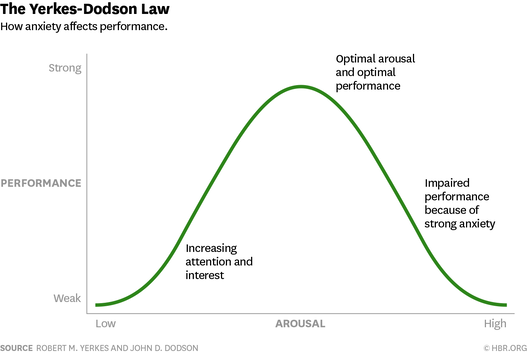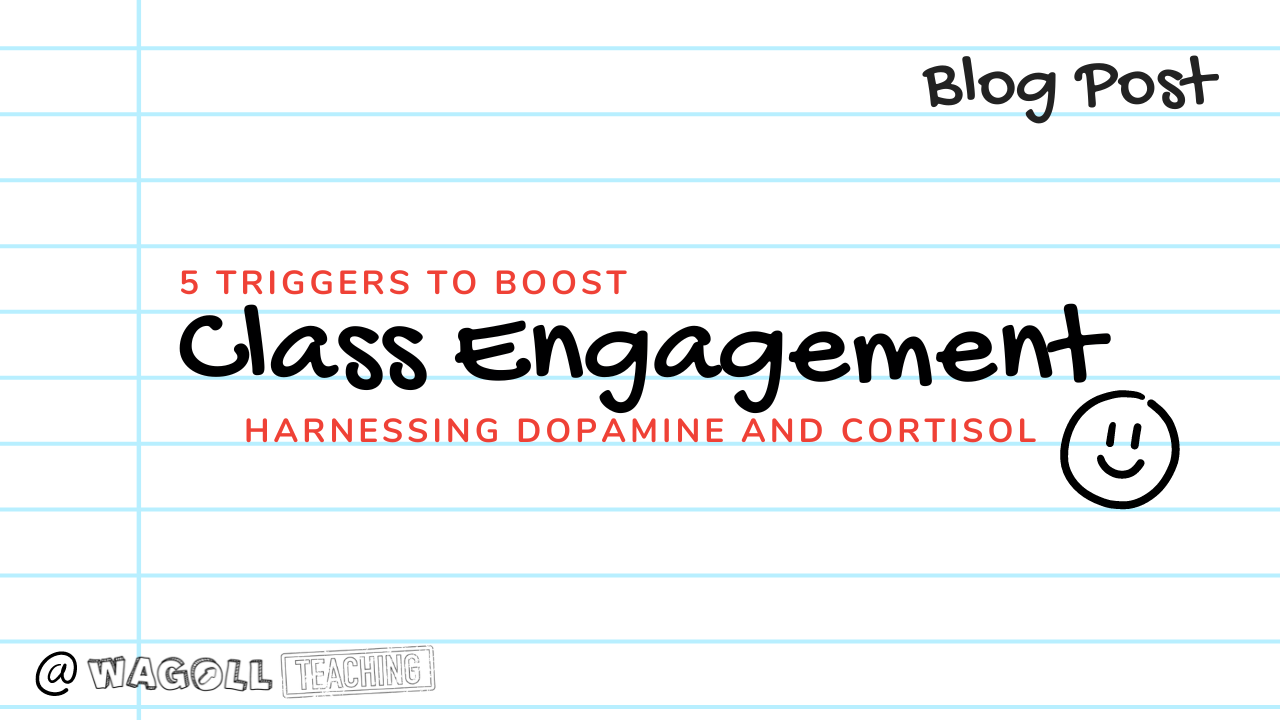|
As a teacher, capturing and maintaining your students' attention is crucial for effective teaching and learning. Understanding the complex relationship between hormones like dopamine and cortisol, and attention can assist with lesson planning. Dopamine, associated with pleasure and reward, plays a critical role in reinforcing positive behaviours and enhancing immediate attention. In contrast, cortisol, the "stress hormone", can either enhance or impair short-term attention depending on its level. By leveraging this knowledge, teachers can create a learning environment that promotes optimal learning and memory performance, and helps students maintain focus and engagement in the classroom. But what is the connection between dopamine, cortisol, and attention, and how can this knowledge be applied to teaching practices to keep students engaged and attentive? Dopamine and CrotisolFirst of all, let me introduce you to dopamine and cortisol. They are two important hormones that play significant roles in learning and memory processes. Dopamine is a neurotransmitter that is associated with pleasure, reward, and motivation. It plays a critical role in the brain's reward system and helps to reinforce behaviours that are associated with positive outcomes. When we experience something rewarding, such as receiving a compliment or achieving a goal, dopamine is released in the brain. This release of dopamine helps to strengthen the neural connections associated with that behaviour, making it more likely that we will repeat the behaviour in the future. Cortisol is a hormone that is released in response to stress. It is often referred to as the "stress hormone" because it is involved in the body's stress response. When we experience stress, cortisol is released, which prepares the body for the fight or flight response. Cortisol can have both positive and negative effects on learning. In small doses, cortisol can help to improve memory and learning by increasing alertness and attention. However, when cortisol levels are too high or prolonged, it can impair learning and memory processes by interfering with the formation of new neural connections. Dopamine helps to reinforce behaviours that are associated with positive outcomes, while cortisol can either enhance or impair learning and memory depending on the circumstances. Yerkes-Dodson Law The Yerkes-Dodson law is a well-known principle in psychology that describes the relationship between arousal and performance. According to this law, performance increases with physiological or mental arousal, but only up to a certain point. Beyond this optimal level of arousal, performance begins to decline. The role of dopamine and cortisol in learning and memory is closely linked to the Yerkes-Dodson law. Reward and motivation can increase arousal and enhance performance up to a certain level. However, if the level of arousal becomes too high, it can interfere with learning and memory processes. This is because excessive arousal can lead to lack of focus, anxiety and stress, which can impair cognitive performance. Similarly, cortisol can also increase arousal and enhance performance up to a certain level. However, if the level of cortisol becomes too high or prolonged, it can impair learning and memory processes, as mentioned earlier. Therefore, the Yerkes-Dodson law suggests that there is an optimal level of arousal that is conducive to learning and memory processes. This optimal level may vary depending on the individual and the task at hand. It is important to manage stress and maintain a healthy balance of arousal to promote optimal learning and memory performance. Too little arousal can lead to boredom and disengagement, while too much arousal can lead to anxiety and stress. What does this mean for attention?The relationship between dopamine, cortisol, and the Yerkes-Dodson law can also be applied to the different types of attention: immediate, short-term, and long-term attention. Immediate attention refers to the capturing student focus at a particular moment. A loud noise in the street will gain our immediate attention. In the classroom, this may be a signal, sound, saying or other stimulus that draws student focus to a specific person or subject within the room. Short-term attention takes this focus one step further. It can refer to the ability to sustain attention over a brief period of time, usually several minutes or across a lesson. Long-term attention refers to the ability to sustain attention over an extended period of time, usually hours, days or weeks. Now that attention has been broken into three different lengths of time, how can different triggers be paired with these in order to think more purposefully about capturing attention? Framing TriggersThe way a moment, activity, lesson or unit is framed to children can support student engagement. A unit on Gymnastics may be better framed as a unit on Street Dance or Parkour to avoid some students, particularly boys with a social anxiety around gymnastics, to engage better. This may capture long-term attention. However, if in a lesson you lean in and whisper a 'top tip' for completing a task, you are suggesting that the top tip is secret, special and important, meaning students are far more likely to utilise the top tip within their work. The whisper captures student immediate attention, while the 'top tip' may support short-term focus for the next 10 minutes of the activity. The Framing Trigger allows teachers to present the next event of learning, be it in the immediate, short or long-term, in particular way so to hook students in that little bit more. When students feel that they are making progress and achieving their goals, they are more likely to stay motivated and engaged. Reward TriggersPossibly the most talked about trigger, but perhaps not always used effectively. Intrinsic reward is closely linked to dopamine. When students engage in activities that we find rewarding, such as solving a challenging problem, learning a new skill, or mastering a task, dopamine is released in the brain. This reinforces the behavior and strengthens the neural connections associated with the task, making it more likely that we will repeat the behavior in the future - long-term attention. When students feel that they are making progress and achieving their goals, they are more likely to stay motivated and engaged. Therefore, making progress and success explicit in your lessons can provide long-term engagement. Short-term attention can be supported too. Providing immediate feedback and recognition for their accomplishments and great behaviour can help to reinforce this sense of achievement, leading to increased dopamine release and engaged children! Familiarity TriggersWhy do so many children love spelling tests? Because, it is familiar and it is routine. Familiarity can support engagement by reducing cortisol, the hormone associated with stress. When we encounter new or unfamiliar situations, our brains release cortisol in response to the perceived stress of the situation. In contrast, when we encounter familiar situations, our brains release less cortisol, which can promote a sense of comfort and relaxation. This can reduce anxiety and promote engagement, as students are less distracted by stress and more able to focus on the task at hand. Familiarity can also provide a sense of predictability and control, which can be comforting and empowering for students. When students are familiar with the expectations and routines of the classroom, they are more likely to feel a sense of control and autonomy, which can increase engagement and motivation. However, it's important to note that familiarity alone may not be enough to sustain engagement and motivation over time. While reducing cortisol through familiarity can help to create a comfortable and supportive learning environment, it's important to also provide opportunities for novelty and challenge, leading to the next trigger... Disruption TriggersWhile familiarity can be beneficial, repetition can lead to boredom and the mundane. There is a place for disruption and novelty in the classroom. As mentioned earlier, dopamine is associated with pleasure, motivation, and reward. When we encounter novel or surprising stimuli, such as a new activity or a challenging problem, dopamine is released in the brain. This can create a sense of excitement and engagement, as students are motivated to explore and learn more. Disruptions and novelty can also increase cortisol levels and arousal, as they introduce a level of uncertainty and stress. In small doses, this can be beneficial, as a moderate amount of stress can help to increase alertness and attention. But if the stress becomes overwhelming, it can impair attention and motivation, leading to feelings of anxiety and distraction. To manage the potential stress of novelty and disruptions, it's important to balance them with familiarity and predictability. Providing a clear and consistent structure to the learning environment can help to reduce stress and provide a sense of control and safety. This can help students to manage the stress of novelty and disruptions, while still reaping the benefits of increased dopamine and engagement. Positive stress, also known as eustress, is a type of stress that is experienced in response to positive or exciting events, such as a challenging task or an upcoming competition. Stress TriggersAs hinted at in the previous heading, positive stress can support engagement through its impact on dopamine and cortisol. While stress is often associated with negative emotions and outcomes, it's important to note that not all stress is bad. In fact, some level of stress can be beneficial, as it can help to promote alertness, attention, and motivation.
Positive stress, also known as eustress, is a type of stress that is experienced in response to positive or exciting events, such as a challenging task or an upcoming competition. A time limit to activities or a target for the number of questions answers are simple examples. The important factor is that the child associates these challenges with positive outcomes. If a failed attempt at completing the challenge is met with negative consequences, a positive stress environment is not being created. When we do experience positive stress, our brains release dopamine, which can create a sense of excitement and engagement. This can motivate us to work hard and stay focused, as we seek to achieve our goals and reap the rewards of our efforts. At the same time, positive stress also triggers the release of cortisol, as the brain recognizes the need to stay alert and focused in the face of a challenging task. However, in small doses, cortisol can actually be beneficial, as it can help to increase attention and focus, and prepare the body to take on the challenge at hand.
10 Comments
Sophie L.
29/3/2023 07:19:32 pm
Thank you so much for sharing. I am in college to become a teacher in the future, and these blogs give me great insight.
Reply
Jess
2/7/2023 10:40:34 pm
I think it's so important to point out all the different triggers and what the differences are when talking about engagement in the classroom. As a future teacher this is so important to recognize. Thanks for sharing!
Reply
Ken Westberg
20/7/2023 07:08:50 pm
I found this article to be very interesting and enlightening. As a middle school teacher I often find the greatest challenge is finding the best way to engage my students in order to create a better learning experience. This article takes a very scientific approach to understanding how to create and maintain engagement.
Reply
Carike Abrahamse
21/8/2023 08:49:10 am
I would really like to know more. Is there a list of references that I can use?
Reply
Aileen
8/11/2023 05:39:12 pm
Your article on classroom engagement triggers was enlightening. The explanation of how dopamine and cortisol impact attention, as well as their connection to the Yerkes-Dodson law, was insightful. Your breakdown of triggers like framing, rewards, familiarity, disruption, and stress provided practical strategies for maintaining student engagement. I think everyone (we were all students before) can relate to a moment where they felt negative stress because of an unfamiliar assignment. Your article is a valuable resource for educators looking to enhance their teaching practices.
Reply
Isaac
26/3/2024 06:49:24 pm
this article serves as a reminder that stress, when managed Effectively and perceived positively, can serve as a catalyst for personal and academic growth. It encourages us to reevaluate our perceptions of stress and harness its potential to drive achievement and success.
Reply
Isaac Ohene
26/3/2024 06:54:16 pm
Ways of creating positive stress
Reply
Marissa
31/5/2024 03:58:12 am
I find the “familiarity triggers” to be incredibly fascinating. I did not realize that creating routines were so comforting that they caused a decrease in cortisol levels and stress for students. This makes perfect sense for me considering I feel incredibly stressed and high strung when my routine is thrown off, it feels exhausting. What an easy way to keep stress levels low by maintaining a predictable routine in your classroom and preparing students ahead of time if that routine may be disrupted.
Reply
10/7/2024 12:45:29 pm
Dopamine and Cortisol for Learning is a fascinating topic!
Reply
Leave a Reply. |
SearchWith a keen interest in the neuroscience and psychology of learning, WAGOLL Teaching is about sharing research alongside great, simple teaching ideas to a global teaching community.
Ben has been in education for over 10 years and is passionate about simplifying high quality teaching and learning through innovative and practical approaches in the classroom. sUBSCRIBE |
|
Who are we? |
With a keen interest in the neuroscience and psychology of learning, WAGOLL Teaching is about sharing research alongside great, simple teaching ideas to a global teaching community.
|
All copyright reserved ©.
I would like to remind all visitors to this website that all pages on this site are copyright protected, unless stated. Most importantly, this site is for the use and enjoyment of all children, parents, guardians, carers and teachers who are involved in WAGOLL Teaching. Please use the resources/ideas as you need without replicating them for your own gains.
I would like to remind all visitors to this website that all pages on this site are copyright protected, unless stated. Most importantly, this site is for the use and enjoyment of all children, parents, guardians, carers and teachers who are involved in WAGOLL Teaching. Please use the resources/ideas as you need without replicating them for your own gains.









 RSS Feed
RSS Feed


